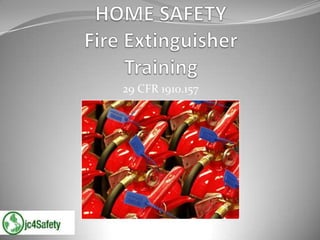
Portable fire extinguishers home safety
- 2. Session Objectives You will be able to: Identify different classes of fire Choose the appropriate type of extinguisher Use a fire extinguisher Inspect and maintain extinguishers
- 3. Fire Triangle Oxygen Fuel Ignition
- 4. Class A Ordinary combustibles Wood Paper Plastic Garbage
- 5. Class B Flammable liquids Grease Gasoline Oil Solvents
- 6. Class C Energized electrical equipment Appliances Switches Panel boxes Power tools
- 7. Class D Combustible metals Magnesium Titanium Potassium and sodium Pyrophoric materials
- 8. Classes of Fires—Any Questions? Any questions about the fire triangle or the different classes of fires?
- 9. Extinguishing the Fire Remove heat Remove oxygen Remove the fuel
- 10. Water Extinguishers Rated only for Class A fires Spread a grease fire Cause an electrical shock on a Class C fire Increase a metal fire
- 11. Dry Chemical Extinguishers Best all-around choice Help prevent re-ignition Make a mess Class ABC contains ammonium phosphate
- 12. Carbon Dioxide (CO2) Extinguishers Class BC-rated Most Contain Carbon Dioxide Should not be used on Class D—metal fires Do not leave a residue Are a good choice for computers or electronics Must be used 3 to 8 feet from the fire
- 13. Metal Extinguishers Class D rated Powdered copper Sodium chloride Form an airtight crust over the fire
- 14. Types of Extinguishers— Any Questions? Any questions about the different types of fire extinguishers?
- 15. Fight-or-Flight Decision Alarm has been pulled Fire dept. has been called Fire is small and contained You can avoid the smoke Exit is clear Extinguisher is nearby You have been trained to use the extinguisher
- 16. PASS Pull Aim Squeeze Sweep
- 17. Inspect Extinguishers Monthly inspection Extinguisher not blocked Pressure is acceptable Pin and seal are intact No dents or damage Performed by EH&S
- 18. Care and Maintenance Keep extinguisher clean Replace if damaged Recharge immediately after use Have hydrostatic testing done Remove non-rechargeables after 12 years
- 19. Locations and Signs Readily accessible Highly visible sign.
- 20. Types of Extinguishers— Any Questions? Any questions about using, inspecting, and maintaining fire extinguishers?
- 21. Key Points to Remember Fire triangle Fire hazard class Know your extinguishers Fight or flight PASS
